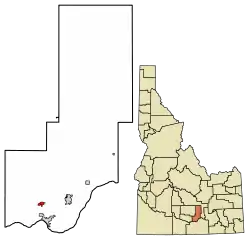Paul, Idaho
Paul is a city in Minidoka County, Idaho, United States founded in 1907. The population was 1,169 at the 2010 census. It is part of the Burley, Idaho Micropolitan Statistical Area. The town received its name from Charles H. Paul, an engineer on the Minidoka Reclamation Project.
Paul, Idaho | |
|---|---|
 Location of Paul in Minidoka County, Idaho. | |
| Coordinates: 42°36′23″N 113°47′0″W | |
| Country | United States |
| State | Idaho |
| County | Minidoka |
| Area | |
| • Total | 0.69 sq mi (1.78 km2) |
| • Land | 0.66 sq mi (1.71 km2) |
| • Water | 0.03 sq mi (0.07 km2) |
| Elevation | 4,150 ft (1,260 m) |
| Population | |
| • Total | 1,169 |
| • Estimate (2019)[3] | 1,449 |
| • Density | 2,198.79/sq mi (849.12/km2) |
| Time zone | UTC-7 (Mountain (MST)) |
| • Summer (DST) | UTC-6 (MDT) |
| ZIP code | 83347 |
| Area code(s) | 208, 986 |
| FIPS code | 16-61210 |
| GNIS feature ID | 0397012 |
| Website | cityofpaul |
Geography
According to the United States Census Bureau, the city has a total area of 0.66 square miles (1.71 km2), of which, 0.64 square miles (1.66 km2) is land and 0.02 square miles (0.05 km2) is water.[4]
Demographics
| Historical population | |||
|---|---|---|---|
| Census | Pop. | %± | |
| 1920 | 527 | — | |
| 1930 | 363 | −31.1% | |
| 1940 | 606 | 66.9% | |
| 1950 | 560 | −7.6% | |
| 1960 | 701 | 25.2% | |
| 1970 | 911 | 30.0% | |
| 1980 | 940 | 3.2% | |
| 1990 | 901 | −4.1% | |
| 2000 | 998 | 10.8% | |
| 2010 | 1,169 | 17.1% | |
| 2019 (est.) | 1,449 | [3] | 24.0% |
| U.S. Decennial Census[5] | |||
2010 census
As of the census[2] of 2010, there were 1,169 people, 446 households, and 311 families residing in the city. The population density was 1,826.6 inhabitants per square mile (705.3/km2). There were 473 housing units at an average density of 739.1 per square mile (285.4/km2). The racial makeup of the city was 76.6% White, 0.9% Native American, 0.8% Asian, 18.0% from other races, and 3.6% from two or more races. Hispanic or Latino of any race were 28.5% of the population.
There were 446 households, of which 34.3% had children under the age of 18 living with them, 56.7% were married couples living together, 7.4% had a female householder with no husband present, 5.6% had a male householder with no wife present, and 30.3% were non-families. 26.7% of all households were made up of individuals, and 13.9% had someone living alone who was 65 years of age or older. The average household size was 2.62 and the average family size was 3.20.
The median age in the city was 34.3 years. 28.7% of residents were under the age of 18; 7.2% were between the ages of 18 and 24; 24.7% were from 25 to 44; 23.5% were from 45 to 64; and 16% were 65 years of age or older. The gender makeup of the city was 51.3% male and 48.7% female.
2000 census
As of the census[6] of 2000, there were 998 people, 409 households, and 276 families residing in the city. The population density was 1,559.4 people per square mile (602.1/km2). There were 430 housing units at an average density of 671.9 per square mile (259.4/km2). The racial makeup of the city was 83.27% White, 0.10% African American, 0.80% Native American, 0.40% Asian, 12.22% from other races, and 3.21% from two or more races. Hispanic or Latino of any race were 16.33% of the population.
There were 409 households, out of which 31.3% had children under the age of 18 living with them, 54.0% were married couples living together, 8.6% had a female householder with no husband present, and 32.3% were non-families. 28.4% of all households were made up of individuals, and 17.6% had someone living alone who was 65 years of age or older. The average household size was 2.44 and the average family size was 2.99.
In the city, the population was spread out, with 27.3% under the age of 18, 7.3% from 18 to 24, 24.7% from 25 to 44, 22.2% from 45 to 64, and 18.4% who were 65 years of age or older. The median age was 39 years. For every 100 females, there were 94.9 males. For every 100 females age 18 and over, there were 90.1 males.
The median income for a household in the city was $30,417, and the median income for a family was $35,179. Males had a median income of $33,375 versus $21,172 for females. The per capita income for the city was $15,627. About 9.8% of families and 14.6% of the population were below the poverty line, including 19.3% of those under age 18 and 9.7% of those age 65 or over.
Education
Paul is served by the Minidoka County Schools system.
Children are zoned to:
- Paul Elementary School (Paul)
- West Minico Middle School (Unincorporated Minidoka County)
- Minico High School (Unincorporated Minidoka County)
See also
References
- "2019 U.S. Gazetteer Files". United States Census Bureau. Retrieved July 9, 2020.
- "U.S. Census website". United States Census Bureau. Retrieved 2012-12-18.
- "Population and Housing Unit Estimates". United States Census Bureau. May 24, 2020. Retrieved May 27, 2020.
- "US Gazetteer files 2010". United States Census Bureau. Archived from the original on 2012-01-25. Retrieved 2012-12-18.
- "Census of Population and Housing". Census.gov. Retrieved June 4, 2015.
- "U.S. Census website". United States Census Bureau. Retrieved 2008-01-31.